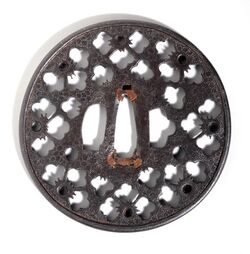Engineering:Sukashibori
Sukashibori (透彫(すかしぼり)) is the Japanese term for openwork or pierced work, using various techniques in metalworking and other media, in which the foreground design is left intact, while background areas are cut away and removed (or the converse may be performed).[1] The resulting piece becomes see-through (sukashi) and hence the name.
Traditional artisans worked on piece of cast metal (or hammered metal[1]) such as bronze as medium. In traditional metalworking (chōkin, 彫金), the carving tools they used were the piercing burin (sukashi-tagane, 透かし鏨)[1] and scroll saw (tsurubiki-noko(?), 弦引鋸).[2]
The type where the foreground pattern is preserved and the background removed is called ji-sukashi (地透し),[1] and the reverse is called moyō-sukashi (文様透し).[1]
In Buddhist art, foliage scrollwork [ja] (唐草模様 karakusa-moyō) or lotus motif is often used[3] The result is an Arabesque-like or lacework-like design. They are featured in the depiction of the kōhai or "rear glow" (the halo or nimbus behind Buddhist statues)[3] as well as the tiara-like headpieces [3] crowning their heads. Other prominent uses are in ritual objects such as keman (pendent ornaments),[3] keko [ja] (華籠 "flower basket"),[3] and kōro (香炉 incense burners).[3] Examples of tsuba (hilt-guard) of the Japanese sword often use sukashibori work.
The word is also applied when used for other material, such a wood; for example, the transom (ranma) may be done in sukashibori work.[3]
See also
References
- ↑ 1.0 1.1 1.2 1.3 1.4 Tokyo National Museum (1976). 和英対照日本美術鑑賞の手引(An Aid to the Understanding of Japanese Art). pp. 132/133. (revised edition; 1964 first ed.), p.132/133
- ↑ Tokyo National Museum 1964, p. 132. 「弦引鋸」is the word used here for the scroll saw, but no other instance of the word can be found in other sources, and the reading of the word is a guess. it may be tsuruhiki nokogiri, for instance
- ↑ 3.0 3.1 3.2 3.3 3.4 3.5 3.6 Shinchosha (1985). 新潮世界美術事典 (Shincho Encyclopedia of World Art). Shinchosha. ISBN 4-10-730206-7.
 |


